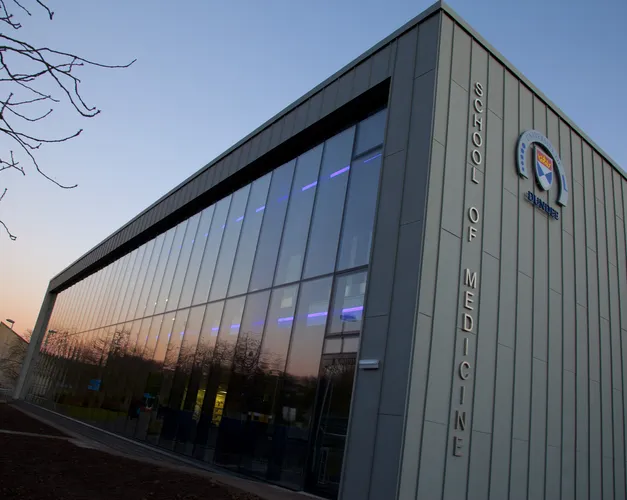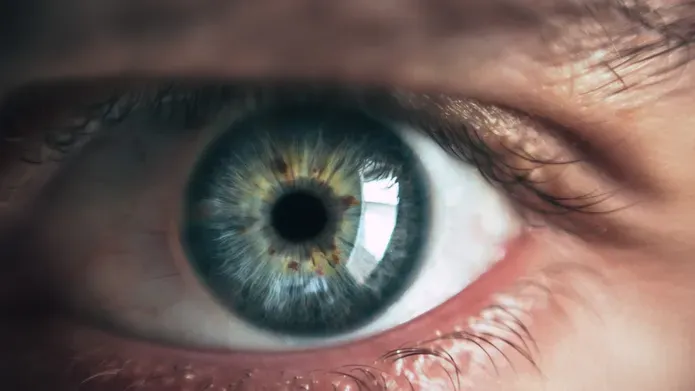Press release
High street eye scan can reveal risk of having a heart attack or stroke
An eye scan already available on the high street can tell someone their odds of having a heart attack or stroke within the next 10 years, a study led by the University of Dundee has found.
Published on 16 July 2025


A simple digital photograph of the back of the eye can predict a major cardiovascular event – such as a heart attack or stroke – set to happen in the next decade with 70 per cent accuracy, according to research supported by the British Heart Foundation and the National Institute for Health and Care Research (NIHR).
Researchers believe the routine retinal scans could also be used to track people’s heart health over time, as they also found links between someone’s three-year change in risk score and their odds of a major cardiovascular event.
The eye scan is analysed using AI, which takes just a fraction of a second to produce a personalised risk prediction. People at the highest risk could be referred to a GP, who might end up prescribing blood pressure tablets or statins to lower their cholesterol.
In the future, researchers hope anyone getting an eye test could get an alert on their heart health pinged to their smartphone.
Dr Ify Mordi, British Heart Foundation Research Fellow at the University of Dundee and consultant cardiologist, led the study published in the journal Cardiovascular Diabetology. He said, “It may be surprising, but the eyes are a window to the heart.
“If there is damage or narrowing of the blood vessels at the back of the eye, there is a good chance that will also be seen in the blood vessels further inside the body, supplying the heart, which could lead to a heart attack or stroke.
“This is a one-stop scan which is routinely performed and takes less than a minute. It could be an important part of the package, alongside blood pressure and cholesterol checks, in identifying people who could benefit from medication or lifestyle changes.”
Researchers at the University of Dundee developed AI technology to analyse digital retinal photographs, which are usually part of a routine eye test on the high street.
First, the AI was instructed to look for red flags such as blood vessel narrowing, blockages and damage, which could be signs of impending heart problems.
Then a ‘black box’ approach was taken, allowing the technology to use machine ‘deep-learning’ to search for any detail it chose in the images, which could range from the size to the arrangement of blood vessels.
After being trained on around 4,200 images, the black box AI was judged on how well the technology could predict those people who went on to have a heart attack or stroke, or die from cardiovascular disease - also usually a heart attack or stroke - in the next decade.
The team found that black box AI predicted 70 per cent of these cases when tested on eye scans from more than 1,200 people.
Some of these people had also undergone a second scan, three years after their first. When the researchers analysed how risk scores identified by AI changed between the scans, they found the fifth of this group with the largest increase in their risk score had a 54 per cent higher risk of a major cardiovascular event than the rest of the group.
This 54 per cent higher risk was seen in people whose AI score increased by as little as three per cent in three years - for example whose 10-year risk of a cardiovascular event rose from 20 per cent to 23 per cent.
The team also compared the AI technology to the prediction people get currently from routine health checks with their GP - their ‘cardiovascular risk score’ - which provides a percentage risk of someone suffering a major cardiac event in the next decade, based on factors like their age, sex, blood pressure reading, cholesterol level and whether they smoke.
Researchers found that the risk score and retinal scan identified almost exactly the same proportion of people at risk of a heart attack, stroke or death from cardiovascular disease.
When both a clinical risk score, the retinal scan and a further genetic test were combined, the accuracy rose to 73 per cent. That means the three together could potentially identify an extra three people in every 100 people at risk of a heart attack, stroke or death from cardiovascular disease.
The AI tool was trialled in the study on people with diabetes, as they get routine retinal scans on the NHS to check for complications affecting the eyes. But researchers say analysis of blood vessels in the eye to judge cardiovascular risk should work for most people, and not just those with diabetes.
The study was a collaboration between clinical researchers who trialled the technology, including Dr Mordi and Dr Alex Doney, at the University of Dundee, alongside computer scientists who developed the AI technology, led by the university’s Professor Emanuele Trucco and Dr Mohammad Syed.
Professor Bryan Williams OBE, chief scientific and medical officer at the British Heart Foundation said, “The more accurately we can detect someone’s risk of a heart attack or stroke, the better the opportunities to prevent these happening.
"Cutting-edge innovations, like the use of retinal scans alongside health checks, could play a role in improving risk prediction, which is important if we are to reach the British Heart Foundation’s goal to prevent 125,000 heart attacks and strokes in the UK by 2035.
“However, more research is needed to show this prediction accuracy is robust, and to determine the feasibility of incorporating retinal scans into clinical practice.”
About the British Heart Foundation
Far too many of us have felt the pain of losing someone we love to cardiovascular disease, the world’s biggest killer. With your support, British Heart Foundation (BHF) powers groundbreaking research to save and improve lives.
Since 1961, your support has helped us fund scientific breakthroughs that are keeping more families together today, from pacemaker technology and portable defibrillators to proving that statins can help save lives. And with your support, our ambitions for the years to come are even bolder.
Every three minutes someone loses their life to cardiovascular disease in the UK. We’re dedicated to powering advances in cardiovascular science and healthcare that will bring us closer to the day that everyone has a healthier heart for longer. But we can’t do it without your support. Together, the next breakthroughs in diagnosing, treating, and preventing cardiovascular disease are in reach.
About the National Institute for Health and Care Research (NIHR)
The mission of the National Institute for Health and Care Research (NIHR) is to improve the health and wealth of the nation through research. We do this by:
- Funding high quality, timely research that benefits the NHS, public health and social care;
- Investing in world-class expertise, facilities and a skilled delivery workforce to translate discoveries into improved treatments and services;
- Partnering with patients, service users, carers and communities, improving the relevance, quality and impact of our research;
- Attracting, training and supporting the best researchers to tackle complex health and social care challenges;
- Collaborating with other public funders, charities and industry to help shape a cohesive and globally competitive research system;
- Funding applied global health research and training to meet the needs of the poorest people in low and middle income countries.
NIHR is funded by the Department of Health and Social Care. Its work in low and middle income countries is principally funded through UK Aid from the UK government.